
Authors: Qian LW, Hu XL, Guan P, Wang D, Li J, Du CB, Song RY
Article Title: An effective way to imprint protein with the preservation of template structure by using a macromolecule as the functional monomer.
Publication date: 2015
Journal: RSC Advances
Volume: 5
Issue: (73)
Page numbers: 59062-59069.
DOI: 10.1039/C5RA08246C
Abstract: In this study, an assumption that a micromolecular monomer could easily permeate into the inside of a protein and alter its conformation, while an inflexible macromolecular monomer may interact with the surface of the protein and thus maintain the integrity of the template protein's structure was proposed for the first time and confirmed by using circular dichroism and synchronous fluorescence spectroscopy. The protein imprinted hydrogels composed of macromolecular monomers or their equivalent micromolecular monomers were characterized and carried out in the competitive adsorption and adsorption isotherm experiments. The adsorption isotherm behaviours described by the Langmuir model revealed that a higher binding affinity was observed between the template protein and imprinted hydrogels made by a macromolecular monomer. The competitive adsorption results also demonstrated the imprinted hydrogels prepared by the macromolecular monomer exhibited much better specific recognition ability to the template protein. Therefore, the strategy of using a macromolecule to imprint could effectively overcome the mutability of protein during the preparation of imprinted polymers, and consequently would promote the development of imprinting technology
Template and target information: protein, ovalbumin, OVA, lysozyme, Lys



Join the Society for Molecular Imprinting

New items RSS feed
Sign-up for e-mail updates:
Choose between receiving an occasional newsletter or more frequent e-mail alerts.
Click here to go to the sign-up page.
Is your name elemental or peptidic? Enter your name and find out by clicking either of the buttons below!
Other products you may like:
 MIPdatabase
MIPdatabase









